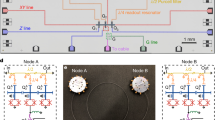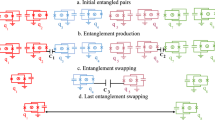Abstract
Traditionally, quantum entanglement has been central to foundational discussions of quantum mechanics. The measurement of correlations between entangled particles can have results at odds with classical behaviour. These discrepancies grow exponentially with the number of entangled particles1. With the ample experimental2,3,4 confirmation of quantum mechanical predictions, entanglement has evolved from a philosophical conundrum into a key resource for technologies such as quantum communication and computation5. Although entanglement in superconducting circuits has been limited so far to two qubits6,7,8,9, the extension of entanglement to three, eight and ten qubits has been achieved among spins10, ions11 and photons12, respectively. A key question for solid-state quantum information processing is whether an engineered system could display the multi-qubit entanglement necessary for quantum error correction, which starts with tripartite entanglement. Here, using a circuit quantum electrodynamics architecture13,14, we demonstrate deterministic production of three-qubit Greenberger–Horne–Zeilinger (GHZ) states15 with fidelity of 88 per cent, measured with quantum state tomography. Several entanglement witnesses detect genuine three-qubit entanglement by violating biseparable bounds by 830 ± 80 per cent. We demonstrate the first step of basic quantum error correction, namely the encoding of a logical qubit into a manifold of GHZ-like states using a repetition code. The integration of this encoding with decoding and error-correcting steps in a feedback loop will be the next step for quantum computing with integrated circuits.
This is a preview of subscription content, access via your institution
Access options
Subscribe to this journal
Receive 51 print issues and online access
$199.00 per year
only $3.90 per issue
Buy this article
- Purchase on Springer Link
- Instant access to full article PDF
Prices may be subject to local taxes which are calculated during checkout




Similar content being viewed by others
References
Mermin, N. D. Extreme quantum entanglement in a superposition of macroscopically distinct states. Phys. Rev. Lett. 65, 1838–1840 (1990)
Aspect, A., Dalibard, J. & Roger, G. Experimental test of Bell’s inequalities using time-varying analyzers. Phys. Rev. Lett. 49, 1804–1807 (1982)
Pan, J.-W., Bouwmeester, D., Daniell, M., Weinfurter, H. & Zeilinger, A. Experimental test of quantum nonlocality in three-photon Greenberger–Horne–Zeilinger entanglement. Nature 403, 515–519 (2000)
Zhao, Z. et al. Experimental violation of local realism by four-photon Greenberger-Horne-Zeilinger entanglement. Phys. Rev. Lett. 91, 180401 (2003)
Nielsen, M. A. & Chuang, I. L. Quantum Computation and Quantum Information (Cambridge Univ. Press, 2000)
Steffen, M. et al. Measurement of the entanglement of two superconducting qubits via state tomography. Science 313, 1423–1425 (2006)
DiCarlo, L. et al. Demonstration of two-qubit algorithms with a superconducting quantum processor. Nature 460, 240–244 (2009)
Ansmann, M. et al. Violation of Bell’s inequality in Josephson phase qubits. Nature 461, 504–506 (2009)
Chow, J. M. et al. Detecting highly entangled states with a joint qubit readout. Phys. Rev. A 81, 062325 (2010)
Neumann, P. et al. Multipartite entanglement among single spins in diamond. Science 320, 1326–1329 (2008)
Häffner, H. et al. Scalable multiparticle entanglement of trapped ions. Nature 438, 643–646 (2005)
Gao, W.-B. et al. Experimental demonstration of a hyper-entangled ten-qubit Schrödinger cat state. Nature Phys. 6, 331–335 (2010)
Wallraff, A. et al. Strong coupling of a single photon to a superconducting qubit using circuit quantum electrodynamics. Nature 431, 162–167 (2004)
Blais, A., Huang, R.-S., Wallraff, A., Girvin, S. M. & Schoelkopf, R. J. Cavity quantum electrodynamics for superconducting electrical circuits: an architecture for quantum computation. Phys. Rev. A 69, 062320 (2004)
Greenberger, D. M., Horne, M. A. & Zeilinger, A. in Bell’s Theorem, Quantum Theory and Conceptions of the Universe (ed. Kafatos, M.) 69–72 (Kluwer Academic, 1989)
Clarke, J. & Wilhelm, F. K. Superconducting quantum bits. Nature 453, 1031–1042 (2008)
Neeley, M. et al. Generation of three-qubit entangled states using superconducting phase qubits. Nature doi:10.1038/nature09418 (this issue).
Koch, J. et al. Charge-insensitive qubit design derived from the Cooper pair box. Phys. Rev. A 76, 042319 (2007)
Schreier, J. A. et al. Suppressing charge noise decoherence in superconducting charge qubits. Phys. Rev. B 77, 180502(R) (2008)
Majer, J. et al. Coupling superconducting qubits via a cavity bus. Nature 449, 443–447 (2007)
Houck, A. A. et al. Controlling the spontaneous emission of a superconducting transmon qubit. Phys. Rev. Lett. 101, 080502 (2008)
Filipp, S. et al. Two-qubit state tomography using a joint dispersive readout. Phys. Rev. Lett. 102, 200402 (2009)
Reed, M. D. et al. High-fidelity readout in circuit quantum electrodynamics using the Jaynes-Cummings nonlinearity. Phys. Rev. Lett. (in the press); preprint at 〈http://arxiv.org/abs/1004.4323〉 (2010)
Strauch, F. W. et al. Quantum logic gates for coupled superconducting phase qubits. Phys. Rev. Lett. 91, 167005 (2003)
Schuster, D. I. et al. Resolving photon number states in a superconducting circuit. Nature 445, 515–518 (2007)
Bishop, L. S., Ginossar, E. & Girvin, S. M. Response of the strongly-driven Jaynes-Cummings oscillator. Phys. Rev. Lett. 105, 100505 (2010)
Acín, A., Bruß, D., Lewenstein, M. & Sanpera, A. Classification of mixed three-qubit states. Phys. Rev. Lett. 87, 040401 (2001)
Altomare, F. et al. Tripartite interactions between two phase qubits and a resonant cavity. Preprint at 〈http://arxiv.org/abs/1004.0026〉 (2010)
Tóth, G. & Gühne, O. Entanglement detection in the stabilizer formalism. Phys. Rev. A 72, 022340 (2005)
Kwiat, P. G., Eberhard, P. H., Steinberg, A. M. & Chiao, R. Y. Proposal for a loophole-free Bell inequality experiment. Phys. Rev. A 49, 3209–3220 (1994)
Acknowledgements
We thank M. Brink for experimental contributions, and L. S. Bishop, E. Ginossar, O. Gühne, C. Rigetti, D. I. Schuster and J. Siewert for discussions. We acknowledge support from LPS/NSA under ARO contract W911NF-05-1-0365, from IARPA under ARO contract W911NF-09-1-0369 and from the NSF under grants DMR-0653377 and DMR-0603369. Additional support was provided by CNR-Istituto di Cibernetica, Pozzuoli, Italy (L.F.), and by CIFAR, MITACS, MRI and NSERC (J.M.G.). All statements of fact, opinion or conclusions contained herein are those of the authors and should not be construed as representing the official views or policies of the US Government.
Author information
Authors and Affiliations
Contributions
L.D.C., M.D.R. and L.S. carried out measurements and data analysis. B.R.J. and J.M.C. provided further experimental contributions. J.M.G. provided theory support. L.F., L.D.C. and L.S. fabricated devices. L.D.C. and M.H.D. wrote the manuscript, with feedback from all authors. S.M.G., M.H.D. and R.J.S. designed and supervised the project.
Corresponding authors
Ethics declarations
Competing interests
The authors declare no competing financial interests.
Supplementary information
Supplementary Information
This file contains additional references and Supplementary Figures 1 - 4 with legends. (PDF 367 kb)
Rights and permissions
About this article
Cite this article
DiCarlo, L., Reed, M., Sun, L. et al. Preparation and measurement of three-qubit entanglement in a superconducting circuit. Nature 467, 574–578 (2010). https://doi.org/10.1038/nature09416
Received:
Accepted:
Published:
Issue Date:
DOI: https://doi.org/10.1038/nature09416
This article is cited by
-
A Review of Developments in Superconducting Quantum Processors
Journal of the Indian Institute of Science (2023)
-
Multipartite unextendible product bases and quantum security
Quantum Information Processing (2023)
-
Noise-Tolerant Superconducting Gates with High Fidelity
Journal of Russian Laser Research (2023)
-
Realizing repeated quantum error correction in a distance-three surface code
Nature (2022)
-
Entanglement in a cavity magnomechanical system
Quantum Information Processing (2022)
Comments
By submitting a comment you agree to abide by our Terms and Community Guidelines. If you find something abusive or that does not comply with our terms or guidelines please flag it as inappropriate.



